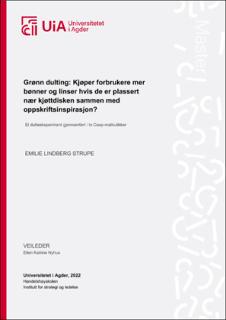Grønn dulting: Kjøper forbrukere mer bønner og linser hvis de er plassert nær kjøttdisken sammen med oppskriftsinspirasjon?
Master thesis
Permanent lenke
https://hdl.handle.net/11250/3036473Utgivelsesdato
2022Metadata
Vis full innførselSamlinger
Sammendrag
The purpose of this study was to investigate a possible solution to increase sustainable food consumption, and the motivation was derived from the current climate crisis. Research has shown that animal protein, like beef, are significantly climate problematic, and consumption must be reduced. Plant protein like beans and lentils, on the other hand, is a sustainable source of protein. Therefore, scientists recommend a shift in protein consumption from animal protein to plant protein. This study aimed to test if nudging can contribute to this shift amongst Norwegian consumers. Based on a review of literature on nudging and behavioural insight, along with previous studies on nudging in relation to food, two interconnected nudges were selected, which focused on placement and inspirational information. These nudges were tested in a field experiment, which consisted of a pre-test, intervention, and post-test, to test the causal effect of the combined nudge on sales of beans and lentils. Sales data for the three time periods were collected and analysed using a regression analysis, along with a review of the sales developments and trends.
Analysis of the sales data resulted in no significant relationship between the intervention and sales of beans and lentils. While it was found a small increase in sales during the intervention, this increase was not significant. The results indicate that nudging through placement and inspirational information can not contribute to increased sustainable consumption alone. On this basis, it is recommended that nudging is not used as a replacement for economic incentives in the supermarkets, like taxes or promotional discounts, but rather as a supplement to these economic incentives, as to increase overall effect. Further research is needed to identify how much and what kind of information that is most effective as a nudge. Further research might also investigate how much of a greater effect economic incentives has when combined with nudges.
